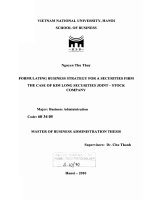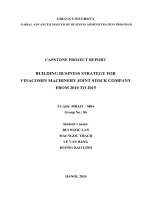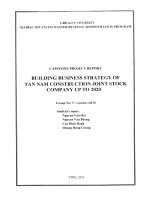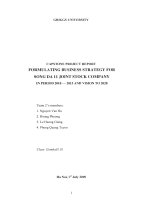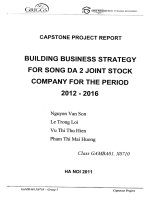Building business strategy for thang long securities joint stock company from 2011 to 2015
Bạn đang xem bản rút gọn của tài liệu. Xem và tải ngay bản đầy đủ của tài liệu tại đây (789.67 KB, 96 trang )
DISSERTATION MBA
Building business strategy for
Thang Long Securities Joint Stock
Company from 2011 to 2015
CONTENT
INTRODUCTION………………………………………………………………….5
CHAPTER 1.........................................................................................................................8
1.1 Overview about business strategy of enterprise......................................................8
1.1.1Concepts.................................................................................................................8
1.1.2Typical features of business strategy....................................................................10
1.1.3The role of business strategy in enterprise...........................................................10
1.2 Process of building business strategy of enterprise...............................................11
1.2.1Define Vision, Mission, Target, Policy and Core thinking..................................11
1.2.2Analyzing external environment..........................................................................12
1.2.3Analyzing internal environment...........................................................................15
1.2.4Building business strategy....................................................................................16
1.3 Tools used to analyze strategies..............................................................................16
1.3.1 SWOT matrix......................................................................................................16
1.3.2Quantitative Strategic Planning Matrix (QSPM).................................................17
CHAPTER 2.......................................................................................................................19
2.1 Overview about TLS................................................................................................19
2.1.1 History of foundation and development..............................................................19
2.1.2Trading sector.......................................................................................................22
2.1.3Organization structure..........................................................................................22
2.1.4Vision and mission...............................................................................................23
2.1.5Business principles...............................................................................................23
2.2 Analyzing external environment of TLS................................................................24
2.2.1Analysis of macro-environment...........................................................................24
2.2.2Analyzing sector environment of securities business...........................................32
2.2.3Opportunities and threats......................................................................................39
2.3 Analyzing internal environment.............................................................................40
2.3.1General business results of TLS...........................................................................40
Table 2.6: Major financial ratios.................................................................................44
2.3.2Operations of the department results....................................................................44
2.3.2.1.Business activities............................................................................................45
2.3.2.2.Support activities for business..........................................................................53
2.3.3.Recognizing strengths and weaknesses...............................................................60
2.4. SWOT matrix TLS..................................................................................................62
64
(S1,T5-6) With development strategy as become investment banking model, TLS
provides services to arrange capital that meet capital demand for enterprises as well
as valuable investment demand of strategic investors. Increase knowledge of
customer about financial services and create them with belief about those services...64
(W2,T2) Increase the work of monitor; foster and promote capacity of machinery as
well as internal audit to increase efficiency and protect capital....................................64
CHAPTER 3.......................................................................................................................66
3.3. Orientation for business strategy of TLS in period of 2011 - 2015.....................66
3.3.2.Strategic targets of TLS.......................................................................................66
3.3.3.Building partial strategies....................................................................................66
2/96
3.4. Selecting business strategy for TLS in period of 2011 - 2015..............................73
3.5. Solutions for implementing business strategy of TLS..........................................75
3.5.2. Solutions on human resource.............................................................................75
3.5.3.Solutions on Marketing.......................................................................................79
3.5.4.Solutions on capital.............................................................................................80
CONCLUSION...................................................................................................................81
3/96
List of symbols and abbreviations
1.
2.
ABS
ACBS
An Binh Securities Joint Stock Company
ACB Securities Joint Stock Company
3.
4.
APEC
BCG
Asia - Pacific Securities Joint Stock Company
Boston Consulting Group
6.
9.
BVS
FPTS
Bao Viet Securities Joint Stock Company
FPT Securities Joint Stock Company
11.
12.
HNX
HSC
Hanoi Securities Trading Department
Ho Chi Minh City Securities Joint Stock Company
13.
14.
HSX/HOSE
KEVS
Ho Chi Minh City Securities Trading Department
Kim Eng Securities Joint Stock Company
15.
16.
QSPM
SBS
Quantitative Strategic Planning Matrix
Sacombank Securities Joint Stock Company
17.
18.
SSI
TLS
Sai Gon Securities Joint Stock Company
Thang Long Securities Joint Stock Company
20.
21.
VNDS
VND
Vndirect Securities Joint Stock Company
Dong
4/96
List of table
Table 1.1: SWOT analysis.................................................................................................17
Table 2.2: Important milestones.......................................................................................19
Table 2.3: Compare some criteria in business TLS against rivals.................................39
List of figure
Figure 1.1: PEST model in macro-environment analysis...............................................13
Figure 1.2: Michael E. Porter’s five force model.............................................................14
List of chart
Chart 2.1: Top 10 brokerage market share in two securities exchanges......................21
Chart 2.2: GDP growth rate Vietnam in period of 2000 - 2010.....................................26
Chart 2.3: Inflation of Vietnam in period of 2000-2010................................................28
5/96
INTRODUCTION
I. The imperativeness of topic
The world economy has been in more stable phase after economic crisis and is
having significant development. Together with general development trend of the
world economy, Vietnam is gradually marking position in global economy. With
the open economy, demand on capital in regard to enterprises increases and become
diversified. Securities market, by means of a part of market. It is useful took to
solve demand on capital.
After 11 years of foundation and development, securities market in Vietnam has
gained significant achievements and steps. At present, there are more than 100
securities companies and each of them self-drives to survive and develop after ups
and downs in market. The ups and downs of market in 2010 and first half of 2011
have made some securities companies recognize efficiency and adjust their trading
activities. Thang Long Securities Company (TLS) is one of the first securities
companies adjusting their development strategy to be able to have improvement in
securities market.
With open tendency of economy, TLS has to face up with more and more rivals not
only domestic ones but also foreign one with strong finance capacity. The increase
of rivals reduces market share of TLS. Although TLS has many competitive
advantages namely strong finance capacity and trademark and over the past years,
TLS always improves to increase prestige and product quality provided customers;
TLS must have development strategy in the future against fiercely competitive
pressure as present. If applicable, the company can control risks, solid steps and
mark position in Vietnam Securities market.
Coming from above problems, our groups realized the particularly important role of
building strategy for existence and development of a securities company. Therefore,
the group decided to select topic in line with the theme “Building business
strategy for Thang Long Securities Joint Stock Company ".
6/96
II. Researching objectives
To systematize basic knowledge and theory of strategic management and
strategy building.
To initially approach to actual operations of securities company in particular and
Vietnam securities market in general.
To apply gained knowledge building strategy for Thang Long Securities Joint
Stock Company.
III. Researching scope
Researching time: we conduct this assignment from 17 July 20011 to 15 August
2011.
Researching scope: Trading activities of Thang Long Securities Joint Stock
Company, Vietnam securities market and some factors in currency market.
IV. Researching methods
Analysis of data from books, newspaper and internet;
Observation from reality of the company;
Summary of appraisal about the company;
Expert method.
5. Structure of capstone project
Chapter 1: Theoretical foundation about building business strategy for
enterprise.
Chapter 2: Analyzing foundation for building strategy of Thang Long Securities
Joint Stock Company.
Chapter 3: Building business strategy of Thang Long Securities Joint Stock
Company in period of 2011 – 2015.
7/96
CHAPTER 1
THEORETICAL FOUNDATION OF BUILDING BUSINESS STRATEGY
OF ENTERPRISE
1.1 Overview about business strategy of enterprise
1.1.1 Concepts
1.1.1.1 Concepts about strategy
From the past up to now, there have been many definitions about strategy
according to different viewpoint groups. We would like to introduce and analyze
some traditional and modern notions to have relatively entire and extensive view
about strategy conception:
According to Alfred Chander (1962): “Business strategy covers definition of
long term basic target of enterprise, selection of method or action program
and allocation of resources to implement that target”.
According to Ansoff H.I (1965): “We can consider strategy as “joint
connection” among activities of enterprise and market consuming products,
it contains four parts: market scope – product, growth rate (changes
conducted by enterprise to match to market scope – definite products),
competitive advantages and resonance”.
According to school of Harvard Business University (1965): “Strategy is
system of goals, targets stated under the form of sectors/business activities
that the company wants to, entry, size, position that the company wants to
achieve and basic policies as well as plans to implement predetermined
targets”.
According to William Glueck (1980): “Business strategy is a united,
comprehensive and cooperative one designed to ensure the enforcement of
basic targets in enterprise” or “Strategy is a united and general one drafted
to gain achievements”.
According Michael Porter: “Strategy is the creation of unique and valuable
8/96
position including differentiation, exchanged selection to focus on resources;
from that it brings advantages for organization”.
From above definition, we can see that strategy relates to long term and basic
goals of an enterprise. Nevertheless, building and selecting the strategy oriented
goals are not enough; strategy must be defined as matching to vision, mission of
organization and methods as well as means to reach those goals the most
effectively. If applicable, it promotes strengths, overcomes weaknesses, makes
use of opportunities and mitigates threats from external environment.
Thus, we can define strategy in general as following: “Strategy is a series of
complex activities to mobilize resources of organization and gain certain
objective.”
1.1.1.2. Concepts about business strategy of enterprise
As mentioned above, strategy related to goals of an enterprise and set forth
strategies must help enterprise gain predetermined goals. Nevertheless, business
strategy has connection to the methods for enterprise to be able to successfully
compete in specific market. It relates to strategic decisions about product
selection,
meeting
requirements
from
customers,
holding
competitive
advantages in comparison with rivals, exploiting and creating new opportunities
According to Fred R.David “Business strategy contains means reach to longterm goals”.
It can say that, business strategy is means helping enterprises reach long term
goals. Business strategy is not to outline specific actions; it is compressive
program, the most effective mobilization solutions for resources with the aim at
conducting predetermined goals.
Business strategy in an enterprise can be defined in following general way:
“Business strategy is an art of designing and organizing means to reach long
term goals of enterprise; it has connection to changes of business
environment and competition”.
9/96
1.1.2 Typical features of business strategy
From viewpoints about strategy mentioned above, strategy still has the most typical
features in any period of time. It reflects the nature of business strategy in enterprise
with the most basic ones such as:
Business strategy defines basic goals and business orientation of enterprise in
each phase.
The orientation of strategy is to ensure the continuous and stable
development in fluctuated business environment for enterprise.
Business strategy ensures the maximum mobilization and optimal
combination in exploiting and using resources of enterprise at present and in
the future. It also upholds advantages, catches opportunities to hold
competitive initiative in market.
Business strategy of enterprise is shown in continuous process from forming
to conducting, assessing and adjusting the enforcement of predetermined
targets.
Business strategy always has idea to fight against and win in business
market.
Business strategy is always built in long term (it may be 3 years, 5 years or
10 years).
1.1.3 The role of business strategy in enterprise
The role of business strategy in enterprise is demonstrated through following issues:
Business strategy helps enterprise define their orientation in each specific
period of time. It is guideline for all production and trading activities of
enterprise.
Business strategy helps enterprise catch and make use of opportunities,
promote strengths and have initiatives to overcome weaknesses, avoid or
respond to mitigate damages from external threats in competitive market.
Business strategy has significant contribution to the effect of using resources,
promotes position of enterprise and ensures the continuous as well as
10/96
sustainable development.
Business strategy creates solid foundation for enterprise to make decisions in
accordance with displacement of market. It also creates solid foundation for
research and deployment, development investment, human resource training,
market expansion and product development.
1.2 Process of building business strategy of enterprise
1.2.1 Define Vision, Mission, Target, Policy and Core thinking
1.2.1.1. Vision
Strategic vision demonstrates the highest and the most general desires and
wishes that organization wants to achieve. We also consider vision as routine of
enterprise in which it shows the destination in the future and the way enterprise
will follow to reach that destination. Or in other words, strategic vision is to
draw a picture of destination together with reasons and means to do.
Defining and stating vision have particularly important role since it gathers
expectations of all members in enterprise and encourages them making efforts to
gain goals, career and noble ideas.
1.2.1.2. Mission
Mission or function is a statement having long term value in objective and
distinguishes this company to others. Such statements are also called as business
philosophy, business principles and belief of the company.
The mission states the existence reason of enterprise. According to Drucker, the
business mission statement gives answer to the question “What is our business
operation?” “What would we do and how would we do to reach the vision
statement?”
1.2.1.3. Target
We can understand target as established achievements which enterprise finds out
all ways to gain while pursuing their mission. The right definition of targets has
remarkably important role to the success of organization since targets map out
development orientation and evaluation for gained results. They also provide the
11/96
view about priority in allocating development resources, foundation to have
effective plan as well as solid basis for assessing result.
Target is considered as a factor if it contains enough measure factors and reality
with obvious apportionment. It also reflects concentration, threats and feasibility
in term.
1.2.1.4. Policy
Fred R.David said that: “Policy is tool to implement strategy as well as the
mean to gain target. Policies include guidelines, principles, regulations and
procedures established to support efforts to gain predetermined targets. Policies
are instruction to make decisions and show repeated situations or recycle
situations”.
1.2.1.5. Core thinking
Core thinking defines long term features of an organization. It is consistent
definition over life cycle of product or market, technological breakthrough, ways
of administration and leaders. In fact, core thinking creates the most important
and stable contributions for success in a company with further vision.
Core thinking is basic and sustainable regulations, principles of organization.
Core values do not need to external defense. They have value and important
within organization. A company must determine value as a core that is
dependent on current environment, competitive environment and administration
methods. In order to recognize core value, we need to sort the honesty and
define the central one.
1.2.2 Analyzing external environment
External environment includes factors, forces and regulations happening out of
enterprise. Enterprise cannot control them but they have significant influences to
efficiency and operation of enterprise.
Recognizing and assessing opportunities and threats from external environment
led enterprise define their mission and functions correctly and obviously.
Furthermore, enterprise can build strategies and reach long term target as well as
12/96
policies to reach annual targets.
External environment contains:
Macro-environment or known as general environment;
Sector environment or known as micro-environment or competitive
environment.
1.2.2.1. Analyzing macro-environment
Macro-environment is the environment covering activities and having direct or
indirect influences to all activities of enterprise.
The main objective of analyzing macro-environment is to acknowledge changes
of anticipated tendencies from factors of external environment. With the
concentration on future, analyzing external environment allows enterprise to
recognize and assess: Opportunities (O) of environment that enterprise can make
use of and Threats (T) facing up enterprise. From that, enterprise builds clear
business functions, defines feasible long term target and designs strategy
matching to business goals.
We can use PEST model to analyze macro-environment. The model includes:
Political
Economics
Socioculture
Technological
Figure 1.1: PEST model in macro-environment analysis
13/96
1.2.2.2.
Analyzing micro-environment
In order to plan strategy, apart from analyzing macro-environment, researching
micro-environment (sector environment) is particularly important. Sector
environment has close connection to enterprise and most of activities and
competitiveness of enterprise directly happen in this kind of environment.
Five force model
In order to clarify competitiveness within industry, Michael E.Porter – professor
of Harvard Business Administration University pointed a frame that helps
administrators realize opportunities and threats facing up enterprises or industry.
The frame of Porter is called as five force model. According to Porter, there are
five force orienting competitiveness within industry regarding as:
-
Power of suppliers;
-
Threats from substitute products;
-
Entry barriers;
-
Power of buyers;
-
Competitive level.
Figure 1.2: Michael E. Porter’s five force model
14/96
1.2.3 Analyzing internal environment
Internal environment of an enterprise includes its internal factors and system. To
survive and develop, every enterprise has to implement management operation
for finance, human resource, trading and production, research and development
as well as marketing. Additionally, they must have information system,
management system, and functional departments in each sector. Each of them
has strengths, weaknesses and defining these factors will help enterprise to build
and select suitable business strategy.
Analyzing internal environment is to define strengths (S) as well as weaknesses
(W) of enterprise.
Strength (S) is the things that business is doing well or feature to help
businesses improve their competitiveness. Strengths can exist in the
following formats:
-
An important skill or experience - the secret to manufacture with low
cost, technological secret, producing without defective products,
experience in providing good customer service, product innovation skill,
commercial skills for product in large scale and unique advertising
promotions;
-
Advantages in material facilities as rich capital, large distribution system;
-
Strong human resource;
-
Advantage in organization and management;
-
The valuable physical property - modern buildings, attractive location,
natural resources stocks;
-
Keep interest position in market: lower cost and better products;
-
Strengths in relationship;
-
Predominant core capacity;
-
Important competitive capacity.
Weaknesses (W) is something that businesses are missing, poor or a
condition pushing enterprises in disadvantage. The internal weakness of the
15/96
business may present:
-
Lack of the significant skills and experience in competition;
-
Lack of resource: human resource, finance;
-
Weak in management and organization ability;
-
Do not have stable input material supplying source;
-
Weak Marketing;
-
Lack of intangible assets, physical assets, organizations, personnel, and
significant competitiveness...
The result of analyzing internal environment is determination of resource,
capacity and core value. From that, enterprise will build competitive strategy
and strategy. However, it is important to be able to build competitive advantage
and maintain it in a sustainable way. And the enterprise is required to understand
the nature and origin of competitive advantage.
1.2.4 Building business strategy
In order to exist and develop in fiercely competitive environment, enterprise
must create competitive advantages. The competitive advantage is shown under
the two basic forms: the lowest cost or product differentiation. Combining the
two basic forms of competitive advantage with operation scale of enterprise, we
will have three general competitive strategies such as:
Cost leadership strategy;
Differentiation strategy;
Focus strategy: this strategy has the two specific forms as cost focus or
differentiation focus.
1.3 Tools used to analyze strategies
1.3.1
SWOT matrix
SWOT analysis model is the useful tool for catching up with and making
decision in every case with respect to any business. SWOT is the abbreviation of
four letters Strengths, Weaknesses, Opportunities and Threats. In a visual way,
SWOt is theory frame and basing on that, we can consider strategies, define
16/96
position as well as direction of an organization, a company. Furthermore, we can
analyze business proposes or any ideas relating to interest of enterprise. In fact,
application of SWOT in business plan, strategy planning, rival assessment,
market research, product development and research report is selected by many
enterprises.
SWOT analysis makes enterprise have through understand about:
Strengths
Weaknesses
Opportunities
Threats
From that, enterprise can make conclusion as the ways to mobilize resources
with internal and external environment the best.
Table 1.1: SWOT analysis
SWOT matrix
O: Opportunities
SO strategies
T: Threats
ST strategies
S: Strengths
Use strengths to make use
Use strengths to avoid
of opportunities
WO strategies
threats
WT strategies
Overcome weaknesses to
Overcome weaknesses to
make use of opportunities
avoid threats
W: Weaknesses
1.3.2 Quantitative Strategic Planning Matrix (QSPM)
QSPM is tool used to decide the best selection for enterprise. QSPM matrix uses
input factors from analyzing EFE, IFE matrix and combination result of analysis
in SWOT matrix to have objective decisions in the best alternative strategies. In
order to develop a QSPM matrix, we have to implement following six steps:
Step1:
List
important
external
opportunities/threats
weaknesses/strengths.
Step 2: Classify internal and external important factors.
17/96
and
internal
Step 3: Determine alternative strategies that the company should consider for
implementation. Collect them into specific groups if possible.
Step 4: Define attractive score of each strategy. The attractive score
demonstrates the relativeness of each strategy in comparison with other. We
only make comparison for strategies in the same group. The attractive score
is classified as follow: 1= not attractive, 2= lightly attractive, 3= quite
attractive, 4= significantly attractive. If successful factors do not affect to
strategy selection, we will not mark attractive score for these strategies.
Step 5: Calculate total attractive score. It is the result of multiply classified
score (step 2) with attractive score (step 4) in each line.
Step 6: Calculate total attractive score for each strategy. It is the addition of
attractive score in each strategic line. The higher and higher score is, the
strategy is more and more attractive.
18/96
CHAPTER 2
ANALYZING FOUNDATION FOR BUILDING BUSINESS STRATEGY OF
THANG LONG SECURITIES JOINT STOCK COMPANY
2.1 Overview about TLS
Thang Long Securities Joint Stock Company (TLS) was established in 2000 and
is one of the first five securities companies in Vietnam with charter capital of
VND 1.200 billion (in which MB has 61,58%). The company has about 600
employees having been trained basically. TLS is one of few companies having
capacity to provide full of services about securities with high quality.
Furthermore, TLS presents in almost big cities in Vietnam as Ha Noi, Ho Chi
Minh, Hai Phong, Da Nang, Vung Tau, Thanh Hoa and Quang Ninh.
Vision of TLS: TLS strives to become the leading investment bank in Vietnam,
operating to the high standards of professionalism.
Company name
: Thang Long Securities Joint Stock Company
Trading name in abbreviation : TLS
Head office
: Floor 6, Toserco building, 273 Kim Ma, Ha
Telephone
Fax
Website
Logo
2.1.1
Noi
: 04.37262600
: 04.37262601
: www.tls.vn
History of foundation and development
After ten years of development, TLS has grown into one of the premier
brokerage houses in the country. Since 2009, TLS has become the number one
brokerage house in terms of market share on both securities exchanges, the
HNX and HSX.
Table 2.2: Important milestones
19/96
No
Time
Event
1
2000
Founded by Military Bank with chartered capital of
VND 9 billion
2
2003
Increased chartered capital to 43 bn VND
Opened Ho Chi Minh City branch
3
2006
Increased chartered capital to 120 bn VND
4
2007
Converted to a joint stock company
Increased chartered capital to 300 bn VND
5
2008
Increased chartered capital to 420 bn VND
6
2009
Increased chartered capital to 800 bn VND
Opened Haiphong branch
Ranked No.1 in terms of market share for securities
brokerage service in the HSX and HNX
7
2010
Increased chartered capital to 1,200 bn VND
Opened branch in Thanh Hoa, Vung Tau and Da Nang
Ranked No.1 in terms of market share for securities
brokerage service in the HNX, HOSE
Events in 2010
Although 2010 is a year with much fluctuation, with direction of managing
committee and unity of all employees in the company, TLS has achieved many
goals, gradually grown, created a solid premise for the major breakthrough in
terms of profit in subsequent years. The first is that TLS has been successfully
held 10-year anniversary of incorporation with many exciting and meaningful
contributions to create the image of a professional financial institution and the
rich nature in the stock market Vietnam. Next is the brand of TLS is recognized
with the award and the title of the year such as:
•
Certificate of Merit” from Hanoi People Committee for achievements and
contribution to the development of Vietnam securities market in the period
2000 – 2010.
•
“Thang Long 2010” Cup Award granted by Hanoi People Committee.
20/96
•
“Outstanding enterprise” in program of “Thang Long – Ha Noi
Intelligence”.
•
“Prestigious Securities Brand 2010” Award by Association of Vietnamese
Securities Business (AVSB) and Vietnam Securities Magazine
•
Ranked in Top 500 Vietnamese largest private enterprises (VNR 500) by
VietNamNet in 2010.
Besides the success in image, in 2010 TLS continued to mark the business
record: keeping leading position on the brokerage market share in both
Exchanges: Hanoi Securities Exchange (HOSE) and Ho Chi Minh City Security
Exchange (HSX), completing model of investment banking; remaining the
development foundation about size and organization completion considered as
solid foundation for the company. Although many indicators have not been
achieved, we can say 2010 was a successful year with TLS in both business as
well as creating a new image of a leading financial institution
Chart 2.1: Top 10 brokerage market share in two securities exchanges
21/96
2.1.2 Trading sector
From the first two stock professions as broker and investment consultant, at present,
TLS has developed all business activities of a securities company and it is shown in
the diagram below:
2.1.3 Organization structure
22/96
2.1.4 Vision and mission
Vision
TLS strives to become the leading investment bank in Vietnam, operating to the
high standards of professionalism.
Mission
TLS’s mission is to bring reliable support to clients, shareholders and employees
through building a dynamic and dedicated talent pool, a trust and prudent
corporate culture and investment in state-of-the-art technology. In addition to
expanding the business, building brand image of a prestigious financial
institution, TLS will always participate and travel with social activities and
community.
Core value
TLS is committed to building an operating environment of trust, respect,
professionalism, efficiency and prudence. This corporate culture is applied
consistently to dealing with each client, business partner and employee in order
to generate premium returns to clients.
Competitive advantages
Leader in the investment industry in Vietnam;
Well trained and professional talent pool with international experiences;
Flexible and diversified financing products;
State-of-the-art technology platform;
High level of business ethics and professionalism; and
Low cost structure.
2.1.5 Business principles
Being one of the leading securities companies in Vietnam, we have been always
adhering to our principals:
Be faithful and consistent in every business activities and adhere to business
ethics;
23/96
Commit to put the customer interests first;
Focus on attracting talents, nurturing well-qualified staff and make a
difference in our activities;
Encourage creativeness and collaboration between individuals;
Be effective in predicting the changes in demands and provide appropriate
services;
Be cautious at thoughts and actions to guarantee benefits of customers; and
Be a responsible citizen by actively participating and organizing social
activities including education and charity.
2.2
Analyzing external environment of TLS
2.2.1 Analysis of macro-environment
The situation in business operation of a company is basic and quite popular
foundation for investors to make decisions. Considering fluctuation in business
of Corporation is to directly predic securities price of the company. Furthermore,
investors can assess business reality of company by means of economic factors
namely: economic growth rate, interest rate, foreign exchange rate and inflation
rate. Last but not least, systematical risks have significant influences to
companies in area of finance especially securities companies and securities
investment funds.
2.2.1.1. Legal factors
Before the integration movement, the Vietnamese enterprises have more
opportunities to develop and face up with difficulties. If a business wants to
stand on international markets, it is required to face with a various factors
beyond their control. Among those factors, politics and law are the two issues of
concern. The success or failure of enterprises in international business arena
largely depends on whether the enterprise understands the policies and laws of
the host country or not. Even where the enterprise is located, it has also been
affected by the system of laws and policies of the government in that local.
24/96
Therefore, we will consider the influence of politics and law to the operation of
TLS.
Influences of legal environment to operations of TLS:
Create an environment of equality for company’s operations and protect the
companies complying with the law with incentives.
Introduce the rules to allow or not allow, bind or require companies to
comply, so the company must strictly observe the rules of law and they will
develop in the right direction.
TLS can have healthy competition with other companies.
Company takes advantage of opportunities and minimizes risk, captures the
attitudes, rules, priorities, maybe even conducts lobbying where necessary to
create a beneficial environment to their operations.
Nevertheless, the law has such changes and addition that makes it has influences
more or less to the company. These new laws often give the new obstacles and
challenges. Therefore, the company must always be ready to deal with new
challenges, new opportunities when having the new rules issued along with the
frequent and rapid changes in socio- economic criteria and legal standards. A
market is closed can be opened so suddenly ... due to the change of law.
Influences of political environment to operations of TLS:
Stable policy is condition for development of the economy and on the contrary,
the development of economy is important factor to make politics stable. On the
other hands, institution and political guildines decide orientation of economic
policies. Additionally, politics has influences to national enterprises through
economy at first. Vietnam is a country considered as having stable politic and
Vietnam wants to make friend with all countries around the world. Indeed, it is
favorable condition for a company to be able to maximize their capacity and
make use of advantages. When politics is stable, the company will attract more
investors. We can say that, stable politics is one of the most concerned issue for
investors. Regarding to stable politics, enterprises will not have to deal with
25/96
